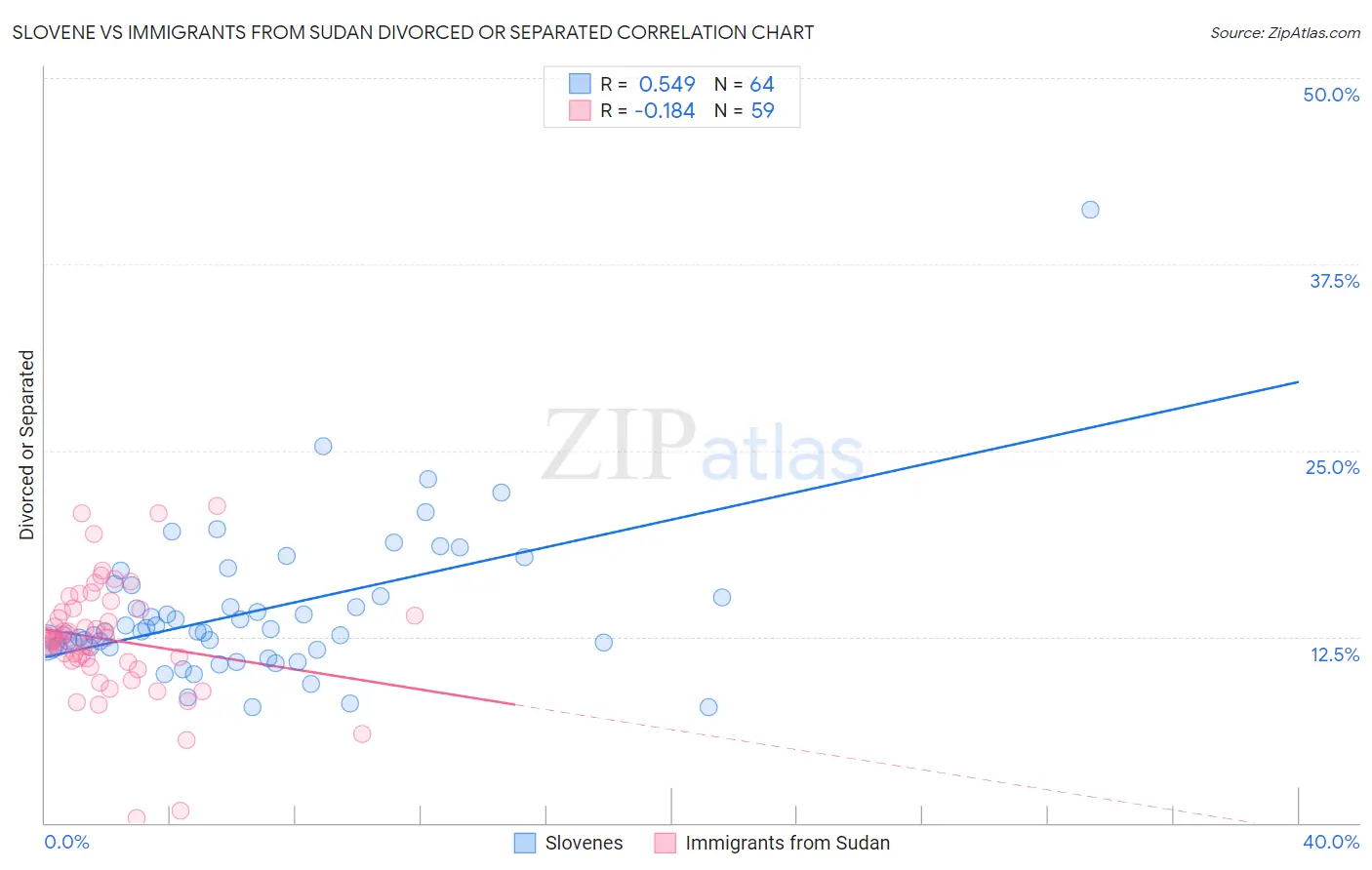Slovene vs Immigrants from Sudan Divorced or Separated
COMPARE
Slovene
Immigrants from Sudan
Divorced or Separated
Divorced or Separated Comparison
Slovenes
Immigrants from Sudan
12.3%
DIVORCED OR SEPARATED
13.2/ 100
METRIC RATING
218th/ 347
METRIC RANK
12.3%
DIVORCED OR SEPARATED
8.2/ 100
METRIC RATING
229th/ 347
METRIC RANK
Slovene vs Immigrants from Sudan Divorced or Separated Correlation Chart
The statistical analysis conducted on geographies consisting of 261,286,451 people shows a substantial positive correlation between the proportion of Slovenes and percentage of population currently divorced or separated in the United States with a correlation coefficient (R) of 0.549 and weighted average of 12.3%. Similarly, the statistical analysis conducted on geographies consisting of 118,963,953 people shows a poor negative correlation between the proportion of Immigrants from Sudan and percentage of population currently divorced or separated in the United States with a correlation coefficient (R) of -0.184 and weighted average of 12.3%, a difference of 0.46%.

Divorced or Separated Correlation Summary
| Measurement | Slovene | Immigrants from Sudan |
| Minimum | 7.7% | 0.30% |
| Maximum | 41.2% | 21.3% |
| Range | 33.5% | 21.0% |
| Mean | 14.2% | 12.3% |
| Median | 12.9% | 12.3% |
| Interquartile 25% (IQ1) | 11.8% | 10.8% |
| Interquartile 75% (IQ3) | 15.6% | 14.3% |
| Interquartile Range (IQR) | 3.8% | 3.5% |
| Standard Deviation (Sample) | 5.0% | 3.9% |
| Standard Deviation (Population) | 5.0% | 3.9% |
Demographics Similar to Slovenes and Immigrants from Sudan by Divorced or Separated
In terms of divorced or separated, the demographic groups most similar to Slovenes are Northern European (12.2%, a difference of 0.11%), Czechoslovakian (12.3%, a difference of 0.11%), British (12.3%, a difference of 0.12%), Immigrants from South America (12.2%, a difference of 0.15%), and Guamanian/Chamorro (12.3%, a difference of 0.15%). Similarly, the demographic groups most similar to Immigrants from Sudan are Immigrants from Cameroon (12.3%, a difference of 0.020%), Yakama (12.3%, a difference of 0.040%), Hmong (12.3%, a difference of 0.070%), Immigrants from Western Africa (12.3%, a difference of 0.12%), and Immigrants from the Azores (12.3%, a difference of 0.16%).
| Demographics | Rating | Rank | Divorced or Separated |
| Immigrants | Eastern Africa | 16.2 /100 | #213 | Poor 12.2% |
| Immigrants | Argentina | 15.5 /100 | #214 | Poor 12.2% |
| Europeans | 15.4 /100 | #215 | Poor 12.2% |
| Immigrants | South America | 15.4 /100 | #216 | Poor 12.2% |
| Northern Europeans | 14.7 /100 | #217 | Poor 12.2% |
| Slovenes | 13.2 /100 | #218 | Poor 12.3% |
| Czechoslovakians | 11.7 /100 | #219 | Poor 12.3% |
| British | 11.6 /100 | #220 | Poor 12.3% |
| Guamanians/Chamorros | 11.3 /100 | #221 | Poor 12.3% |
| Bangladeshis | 10.5 /100 | #222 | Poor 12.3% |
| Scandinavians | 10.4 /100 | #223 | Poor 12.3% |
| Immigrants | Azores | 9.7 /100 | #224 | Tragic 12.3% |
| Belgians | 9.7 /100 | #225 | Tragic 12.3% |
| Immigrants | Western Africa | 9.3 /100 | #226 | Tragic 12.3% |
| Hmong | 8.8 /100 | #227 | Tragic 12.3% |
| Immigrants | Cameroon | 8.3 /100 | #228 | Tragic 12.3% |
| Immigrants | Sudan | 8.2 /100 | #229 | Tragic 12.3% |
| Yakama | 7.8 /100 | #230 | Tragic 12.3% |
| Yugoslavians | 6.6 /100 | #231 | Tragic 12.3% |
| Canadians | 5.3 /100 | #232 | Tragic 12.4% |
| Malaysians | 4.8 /100 | #233 | Tragic 12.4% |